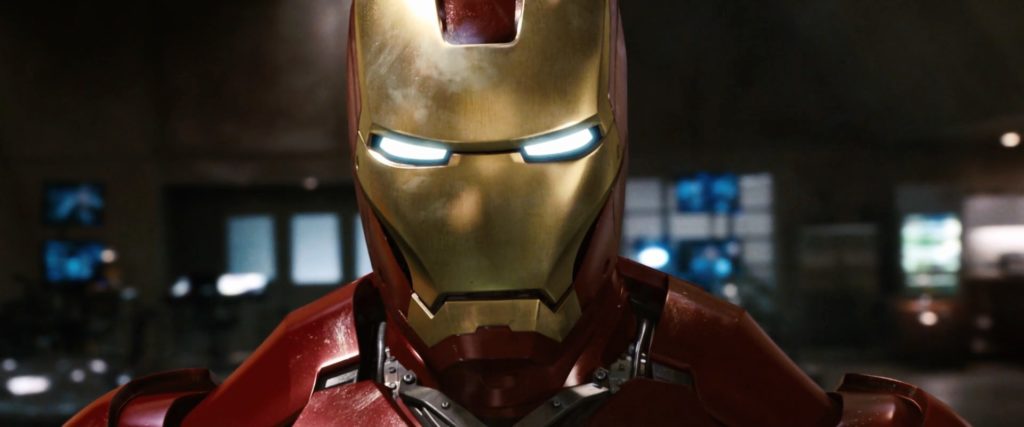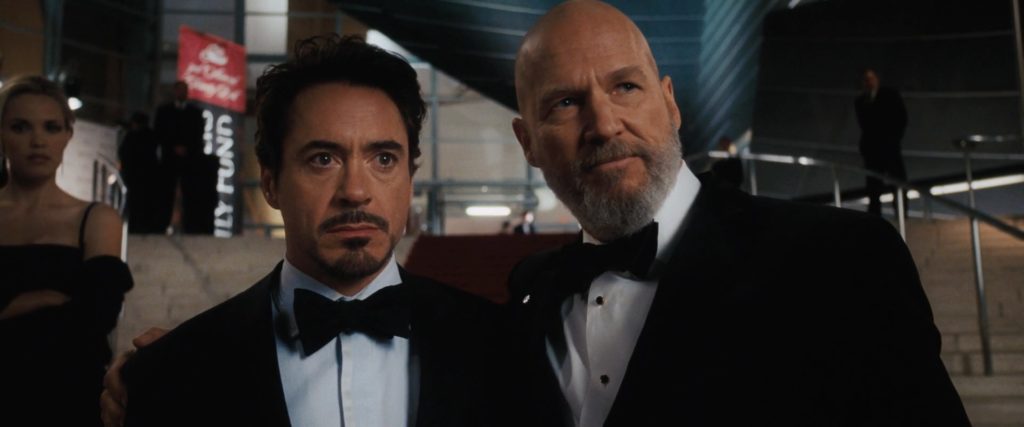In this weekly series, we chronicle the long road undertaken by the Marvel Cinematic Universe movies to arrive at Avengers: Infinity War. We introspect and discuss the movies from a critical and commercial standpoint while also considering the development efforts that went behind them. These articles may be occasionally sprinkled with spoilers so please make sure to skip the relevant sections when reading.
This post is about the 2008 movie Iron Man, the first chapter in the Marvel Cinematic Universe.
Once upon a time, there was no Marvel Cinematic Universe. In fact, there was no Marvel Studios either. Instead, there were Sony and Fox and Paramount. There was no Captain America or Doctor Strange or The Avengers. Instead, there was Spider-Man and there were the X-Men and the Fantastic Four. About a decade and a half ago, it seemed inconceivable for anyone to imagine a young new movie studio come into existence and become a force to be reckoned with, challenging the might of established players in the increasingly popular superhero movie genre. That Marvel’s own movie universe would grow on to outlive 18 films and spawn multiple sub-franchises in itself seems like something straight out of Walt Disney’s journey in the 1900’s. And now, $13.7 billion in with some of its biggest entries yet to grace the big screen, the start of this long voyage has acquired something of a cult status and significance akin to the root of a sprawling tree.
It wasn’t all smooth sailing though both for Marvel Studios in general and Iron Man in particular. Plagued by years of production troubles and development roadblocks, Marvel had a tough time getting Iron Man off the floors. The tumultuous project was passed on from Universal Studios in the 1990s to 20th Century Fox in 1997 to New Line Cinema in 2000 and beyond before finally reverting back to Marvel in 2005. Stars like Nicolas Cage and Tom Cruise came close to playing the titular character, directors Stuart Gordon and Nick Cassavettes close to directing with everyone from Ted Elliott, Terri Rossio, and Tim McCanlies to Alfred Gough, Miles Millar and David Hayler and even Stan Lee himself taking a stab at writing the story. But for whatever reason, nothing seemed to get Iron Man off the ground and for a long time Marvel, increasingly seeking more creative and financial control over their projects, would knock around studio doors in its hopes to get its own movie universe started.
The efforts were largely led by a closely knit group of creatives and geeks spearheaded by then 33-year old Kevin Feige. A fan of comic books and crossovers Feige had ambitions of doing to the movie world what Marvel did with the comic world – creating a singular shared universe of characters with interconnected plotlines and an overarching narrative where stories would weave in and out of one another. The plan was considered so ambitious at the time that Marvel head Avi Arad, behind such Marvel hits as Spider-Man and X-Men expressed doubts over its viability and resigned from the project in 2007, leaving Feige in-charge of what would later become Marvel Studios. He and a group of people formed the braintrust behind Marvel Studios movies and would come to be referred to as the Marvel Creative Committee. Together they were able to secure a loan from Meryll Lynch to the tune of $525 million which helped set things in motion.
 After much dallying around, Marvel was finally able to attach a director to the project. The director, Jon Favreau couldn’t be more thrilled at the prospect of directing a superhero movie for Marvel; he would end up losing 70 pounds over the course of directing the film. He had a monumental task ahead of him and one of the starting points was getting the right actor to play the titular role. Hesitant to go with stars for the baggage they bring, Favreau eventually chose Robert Downey Jr. who had just come out of a turbulent phase in his life that saw him do drugs and prison time. Marvel was understandably apprehensive of casting an actor with such a background to kick-off their universe. Then again, Tony Stark wasn’t a saint either and had a likable asshole quality to him that Favreau felt, Downey Jr. was perfectly capable of conveying with the emotional journey he himself had been through. Putting his foot down, he was able to convince executives that Downey Jr. was right for the role and with that pivotal decision, Favreau would inadvertently end up setting the tone of Iron Man and perhaps the Marvel Cinematic Universe in general. Of course Favreau truly had no idea what he was truly in for, and neither did he anticipate what his creation would spark.
After much dallying around, Marvel was finally able to attach a director to the project. The director, Jon Favreau couldn’t be more thrilled at the prospect of directing a superhero movie for Marvel; he would end up losing 70 pounds over the course of directing the film. He had a monumental task ahead of him and one of the starting points was getting the right actor to play the titular role. Hesitant to go with stars for the baggage they bring, Favreau eventually chose Robert Downey Jr. who had just come out of a turbulent phase in his life that saw him do drugs and prison time. Marvel was understandably apprehensive of casting an actor with such a background to kick-off their universe. Then again, Tony Stark wasn’t a saint either and had a likable asshole quality to him that Favreau felt, Downey Jr. was perfectly capable of conveying with the emotional journey he himself had been through. Putting his foot down, he was able to convince executives that Downey Jr. was right for the role and with that pivotal decision, Favreau would inadvertently end up setting the tone of Iron Man and perhaps the Marvel Cinematic Universe in general. Of course Favreau truly had no idea what he was truly in for, and neither did he anticipate what his creation would spark.
With Downey Jr. on board and pre-production now in full-swing, the remaining cast members were gradually filled in. Terrence Howard was booked for Tony Stark’s longtime friend, confidante, MIT batchmate and military advisor Lieutenant Colonel James Rhodes, Gwyneth Paltrow for his secretary Virginia Pepper Potts, Jeff Bridges as his business partner Obadiah Stane and Clark Gregg as Phil Coulson, agent of the then mouthful Strategic Homeland Intervention Enforcement and Logistics Division later on shortened to S.H.I.E.L.D. Together, these would become enshrined in MCU history as the first characters to become introduced in that ever-expanding universe, some going on to attain more fame and recognition than others. Iron Man filmed between March – June 2007, just in time for a sizzle reel to be presented at Marvel Studios’ first ever Comic-Con panel.
 The reaction to the footage was ecstatic to say the least. Whatever doubts Marvel executives had about the movie’s potential would be quashed to a huge extent by the crowd going wild at Robert Downey Jr. in full display as Tony Stark, demoing the Jericho missile in what was an improvised and now legendary speech. The Comic Con reel can still be found on YouTube if you look for it; credit to the fan-loving Marvel for not taking it down still. If there’s any single scene that can be credited with selling a character to an audience, it has to be the Jericho missile presentation sequence. Wisely enough, Marvel would choose these sequences to open Iron Man in 2008.
The reaction to the footage was ecstatic to say the least. Whatever doubts Marvel executives had about the movie’s potential would be quashed to a huge extent by the crowd going wild at Robert Downey Jr. in full display as Tony Stark, demoing the Jericho missile in what was an improvised and now legendary speech. The Comic Con reel can still be found on YouTube if you look for it; credit to the fan-loving Marvel for not taking it down still. If there’s any single scene that can be credited with selling a character to an audience, it has to be the Jericho missile presentation sequence. Wisely enough, Marvel would choose these sequences to open Iron Man in 2008.
In retrospect, what is striking, and often refreshing about Iron Man is the level of freedom the cast enjoyed in improvising sequences while still maintaining the tight coherence of a narrative thread. The story goes that Marvel was more focused in plotting the story and action beats, ensuring the film flowed smoothly and made sense in its grounded universe while leaving much of the details of the banter between its characters to the cast themselves. This went completely in favor of Robert Downey Jr. who seized the opportunity to come up with some of the movie’s best quirks including the missile demonstration or asking the press to sit down during a conference or even the numerous quips between him and his secretary, Pepper Potts. It wasn’t so easy for the other members of the cast who were well used to the scripted nature of movies and had to match up to Downey’s spirits.
People are quick to compare and point out the similarities between Iron Man to Batman. They’re both filthy rich, flirtatious socialites and, handicapped of superpowers, use their genius to come up with a slew of gadgets and devices they use. But while Bruce Wayne’s actions are driven by a deeply personal tragedy, Tony Stark’s superheroism is a direct response to the less-personal but equally tragic circumstances he goes through. In the context of the movie, Stark, kidnapped by Afghanistan terrorists using his own weapons, is held in captivity in a remote cave and ordered to build them a missile. Assisting him in his efforts is another imprisoned engineer Yinsen. Together, they both understand that the fighters of The Ten Rings are not going to let them out so easily and instead build a suit or armor to blast their way out of the cave. With Yinsen sacrificing himself to buy Stark some time to load the suit’s software, Stark lays waste to as much of the terrorist base as he can and escapes. A rejuvenated Stark wows to shut down his company’s weapons manufacturing facility and develop a much sleeker version of his Iron Man armor to use his life to do some good, in the process attaining the wrath of his longtime ally and business partner Obadiah Stane.
 Iron Man presented a unique challenge with its protagonist. It had the arduous task of making a cocky womanizer and wealthy billionaire who made his living manufacturing weapons into someone the audiences could root for. It’s incredibly hard to give such a persona emotional resonance, harder still to have him be a superhero role model that others aspire to emulate. Still Favreau and his writing team accomplished a fine balancing act, teetering moments of bad boy behavior with sparks or glimpses of righteousness. Whether it’s Yinsen final words to Stark inspiring him to not waste his life, his impulsive decision to shut down his weapons manufacturing business sending company stock into a downward spiral or the anger he feels upon realizing he’s been betrayed by Obadiah and his subsequent flight to save the villagers in Yinsen’s hometown of Gulmira, these sequences have a strong emotional resonance that’s hard to pull off for a character like Stark. And despite the depth of Stark’s conscience at play, Favreau doesn’t shy away from flourishing the movie with generous dozes of humor. This balance of humor and emotion would form the centerpiece of the strategy followed by future MCU films.
Iron Man presented a unique challenge with its protagonist. It had the arduous task of making a cocky womanizer and wealthy billionaire who made his living manufacturing weapons into someone the audiences could root for. It’s incredibly hard to give such a persona emotional resonance, harder still to have him be a superhero role model that others aspire to emulate. Still Favreau and his writing team accomplished a fine balancing act, teetering moments of bad boy behavior with sparks or glimpses of righteousness. Whether it’s Yinsen final words to Stark inspiring him to not waste his life, his impulsive decision to shut down his weapons manufacturing business sending company stock into a downward spiral or the anger he feels upon realizing he’s been betrayed by Obadiah and his subsequent flight to save the villagers in Yinsen’s hometown of Gulmira, these sequences have a strong emotional resonance that’s hard to pull off for a character like Stark. And despite the depth of Stark’s conscience at play, Favreau doesn’t shy away from flourishing the movie with generous dozes of humor. This balance of humor and emotion would form the centerpiece of the strategy followed by future MCU films.
Because of its improvised nature, and Favreau’s insistence on grounding the movie with a semblance of logic (he refused to use The Mandarin in the first movie for this very reason), Iron Man feels pleasantly surprising and a breath of fresh air even a decade from its original release. Especially 10 years later, now that criticism of all Marvel movies “feeling” the same abounds. And since it harks back to the origins, we get to see Iron Man being built from the ground-up by Tony Stark. No literally, we see Stark working on the nitty-gritties of the Iron Man armor, running tests and iterating upon the design, an aspect that was and is very much a staple of the comics. And this doesn’t happen in a montage-like sequence that is generally the norm with such suit-ups; we see Stark and his butler J.A.R.V.I.S. (Just A Rather Very Intelligent System) engage in generous amounts of banter and dialogue to fine tune the Iron Man armor to his specifications. Showing the suit being built from the ground-up is among my personal favorite aspects about the movie at large.
One of the things Iron Man does that is lacking from plenty of modern-day superhero fare is that it restricts and localizes the scale of the central conflict. The antagonist, Obadiah Stane then is not about world domination but about corporate greed. The reason he wants to get rid of his nemesis Stark is not necessarily because they’re on opposite sides of righteousness but because Stark is an obstruction to Stane’s goal of taking over Stark Industries and selling the arc-reactor technology to make a profit. In that sense, Iron Man mirrors albeit exaggeratedly, modern-day business rivalries and is in spots, evocative of even Steve Jobs’ board of directors conspiring to oust him from the company he created. That sense of real-world conflict is something I enjoy watching, no matter how many times I’ve seen the movie.
The visuals really help sell the notion of a sturdy suit of Iron Man armor. Developed by Stan Winston’s studios, the last movie Winston worked on before his demise, Favreu’s origin story blends practical effects seamlessly with digital effects from Industrial Light and Magic (ILM), who Favreau would hire after being enthralled with Pirates of the Caribbean: At World’s End and Transformers. Quite frankly ILM was the best choice for the movie with their experience with Transformers; they brought a ruggedness and tangibility to the suits that really makes the fully realized feel believable and present on set. The scratches on the face and the damage taken by the armor all helped sell the look rather convincingly. In fact, Iron Man is a technically outstanding movie on every level, whether its the music by Ramin Djawadi that has a AC/DC feel to it and yet plays to the character’s strengths or the tight editing which helps keep the run time at just over 2 hours while managing to cram in plenty for viewers to munch on.
 Iron Man was essentially a huge gamble for the studio. Marvel had secured $525 million in funding to kick-start their universe and with their first endeavor budgeted at $140 million, everything hinged upon the success of Iron Man. Iron Man was in essence, the first truly independent and self-created film by the then upcoming Marvel Studios and its reception would determine how audiences would respond to further efforts by the nascent enterprise. Turns out both audiences and critics responded well, the former to the amount of $585 million worldwide and the latter to the tune of a 94 percent Rotten Tomatoes Certified Fresh approval rating. It was one of the rare instances back then that an original superhero film was enjoyable, lighthearted fun and yet well-received and it served as a stark contrast to the seriousness that would grip the superhero genre two months later with Christopher Nolan’s The Dark Knight.
Iron Man was essentially a huge gamble for the studio. Marvel had secured $525 million in funding to kick-start their universe and with their first endeavor budgeted at $140 million, everything hinged upon the success of Iron Man. Iron Man was in essence, the first truly independent and self-created film by the then upcoming Marvel Studios and its reception would determine how audiences would respond to further efforts by the nascent enterprise. Turns out both audiences and critics responded well, the former to the amount of $585 million worldwide and the latter to the tune of a 94 percent Rotten Tomatoes Certified Fresh approval rating. It was one of the rare instances back then that an original superhero film was enjoyable, lighthearted fun and yet well-received and it served as a stark contrast to the seriousness that would grip the superhero genre two months later with Christopher Nolan’s The Dark Knight.
In what would become a tradition going forward, Marvel added a sly post-credits stinger. That short scene saw Samuel L. Jackson introduce himself as Nick Fury, the director of S.H.I.E.L.D. pitching the idea of an “Avenger initiative” to a bewildered Tony Stark. The scene was famously cut out of preview screenings to convince the audience that no such scene existed and maintain its secrecy; turns out people had already gotten wind of it through the internet. In that moment, Nick Fury was metaphorically talking to us, the viewers, asking us if we were interested in taking the Avengers initiative forward.
And interested we certainly were as the movies ahead would prove.





